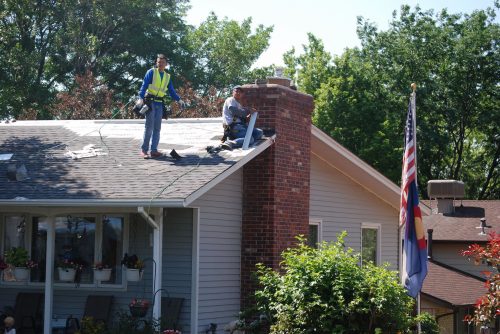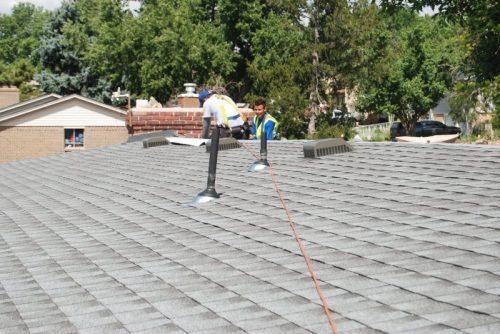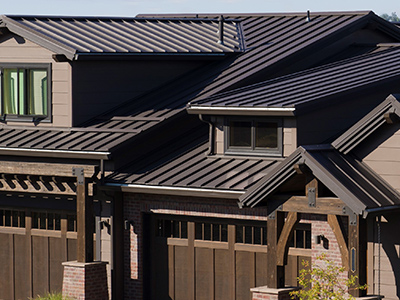The Essential Guide to Repairing Your Roof After Storm Damage
The roof of your home is one of the most important parts. It protects you from the elements, keeps out pests and other intruders, and can even add to the overall aesthetic appeal of your property. Unfortunately, storms can cause significant damage to a roof that needs to be repaired in order for it to continue functioning properly.
If your home or business has been affected by a severe storm, it’s important to get the roof repaired as soon as possible. Otherwise, you could be at risk for further damage. But how do you know if your roof needs to be repaired? And what are the best ways to go about it? This guide will give you the essential information you need to know about repairing your roof after storm damage.

Assess the damage to your roof after a storm.
After a storm, the damage to your roof can be serious and costly. High winds, hail, and other debris can cause shingles to fly off of your home’s roof or damage flashing that keeps water out. It is important to inspect for missing shingles, damaged flashing, water stains, and other signs of weather-related wear and tear in order to make any necessary repairs or replacements quickly.
The first step to assessing the damage is to carefully inspect your roof from the ground. Look for missing or damaged shingles and check around chimneys, vents, and other edges of the roof for any signs of wear and tear. If you have access to a ladder, use it to get closer inspect these areas more closely as well as the flashing around them. You should also check for water stains or signs of leakage on the interior walls or ceilings of your home.
You can then inspect any attic space in your home for signs of air leaks, which may indicate that there is damage to the roof decking or insulation. If you’re unable to access an attic, you can hire a professional to inspect for these issues.
After performing your roof inspection, make sure to document any evidence of damage in the form of photos or video recordings. This will help you when making an insurance claim and provide proof that the damage was due to weather-related events outside of your control.
If there are any damaged or missing shingles, replace them as soon as possible.
Having a roof over your head is one of the most essential elements of any home. Not only does it provide shelter from the elements, but it also helps to keep out pests and other intruders. While a roof may look like a single structure, there are actually many components that work together in order for it to be strong and durable. One such component is shingles, which can often be seen as small overlapping tiles on top of the roof. Shingles play an important role in protecting your roof from harsh weather conditions and other damage, so if any are missing or damaged they should be replaced immediately.
Replacing shingles is an essential part of maintaining the integrity of your roof. As they age, they can become brittle and more prone to breaking or cracking under pressure from weather or other impacts. By replacing them regularly you can ensure that your roof remains strong and reliable for years to come. Additionally, if any shingles are missing or damaged, replacing them quickly is important in order to avoid any further damage or degradation of the roof.
When it comes to actually replacing shingles, there are a few steps you need to take. First, make sure that your roof is safe and free from any debris or other materials that could hinder your work. Next, remove the old shingles and check for any underlying damage that may need to be addressed before the new ones are installed. Finally, install the new shingles in their place, using nails or other fasteners to secure them firmly in place. Make sure all of the nails used are galvanized so they won’t rust over time.
It is important to replace shingles quickly when they become damaged or lost. This is because leaving them unrepaired can lead to further damage and degradation of the roof, costing you more money in repairs down the line. Additionally, if a large portion of your roof’s shingles is missing or damaged, it can cause the roof to become structurally unsound, which can put your family at risk of injury. So if you notice any problems with your shingles it is important to address them quickly and efficiently in order to protect your home.
Placing a tarp on the roof until repairs can be done is a temporary solution but all damage should eventually be addressed. Inspecting and cleaning the roof after every storm is essential for preventing long-term issues and keeping it in good shape – and replacing any missing or damaged shingles should be one of your highest priorities. With regular maintenance and care, you can prevent more extensive problems that may require extensive and expensive repair or replacement of your entire roof.
Inspect your gutters and downspouts to make sure they’re clear of debris.
After a storm, it’s important to check your home’s exterior for damage. Look for dents, dings, and holes in your windows, doors, and cladding.
Inspect your gutters and downspouts, too, to make sure they’re clear of debris. Clogged gutters can overflow and cause other problems.
Gutters
Gutters and downspouts are installed along a roof’s edge to capture runoff from rain and direct it away from the house. When they become clogged, they fail to do this properly and can cause leaks or even structural damage. If the gutters are clear of debris and secured firmly to the roof, this can help prevent future storm damage from occurring. It’s a good idea to inspect your gutters and downspouts after every storm, especially during hurricane season.
Inspect the gutters for dents, holes, sagging, loose hangers, and problems at the seams. These can weaken the structure of the gutters and cause them to fall. If the gutters have dents, it may be time for a replacement. It’s also a good idea to check the downspouts for any signs of hail damage. Hail can cause small asphalt granules to chip off the roofing and wash them into the downspout. This can also cause pooling water in specific areas of the gutters.
Downspouts
Gutters and downspouts are a crucial part of keeping your house safe from water damage. After a storm, inspect them to make sure they’re clear of debris and don’t have holes or dents.
Dented gutters can cause water to back up and leak through. Look for dents in the metal as well as tiny granules of asphalt from your roof. If your gutters are leaking, you need to fix them as soon as possible.
This can prevent rot and mold from growing on your home’s exterior. Sagging gutters can also cause water to flow too close to the house, which can cause serious problems. The gutters need to slope slightly away from the house, so they’ll drain efficiently.
If your gutters have clogs, use a hose to spray down the downspouts and flush debris out. If the clog remains, use a plumber’s snake to break up the debris.
Fascia
After a storm, inspect your gutters and downspouts to make sure they’re clear of debris. This helps prevent rainwater from clogging and flooding your house. If you see water stains or leaks along the seam of your ceiling or wall, then it’s probably coming from the gutters. It’s important to get your gutters looked at right away.
The fascia board is what holds your gutters up and if the wood rots, your gutters will fall off your home. Fascia board rot is one of the most expensive repairs on your gutter system. Another thing to look for is your drip edge. This thin strip of vinyl or aluminum is arguably the most underrated component in your gutter system.
Without it, water can run over your roof shingles, damage your siding and foundation, and even wick into the interior of your home. Ensure your drip edge is installed correctly and you can avoid the cost of extensive repairs later down the road.
Soffit
Gutters are one of the most important parts of a home’s drainage system. Without them, rainwater can seep into the soil around your foundation, causing serious moisture problems like mold and mildew. Your gutters need to be free of leaves, twigs, and other debris so that water can drain properly. They’re also a good place to check for cracks and gaps.
A clogged gutter can also cause water to back up and drip over the roof, damaging siding, fascias, and soffits. It can also lead to basement flooding. Downspouts are vertical pipes that connect to your gutters and divert water away from your home. They’re usually placed at the corners of your home where the gutters intersect. They’re attached to the outside wall of your house and secured with fasteners.
After a storm, one of the most important but often overlooked tasks is inspecting your gutters and downspouts. Without properly functioning gutters and downspouts, water can pool around your roof and cause further damage due to leaks or premature aging. It’s always a good idea to take the extra step of making sure that these areas are clear of debris so that they can effectively take on the job of channeling rainwater away from your roofline. Small efforts like this can go a long way toward staving off bigger repairs in the future.

Check for any cracked or broken tiles, and replace them if necessary.
Keeping your tile roofing in good condition is essential for both safety and aesthetic reasons. Regularly inspecting it for any signs of wear and tear, such as cracks or broken tiles, is an important part of home maintenance that should not be overlooked. Cracked or broken tiles can not only detract from the overall look of your home but also pose a safety hazard if left unchecked. If you do find any damaged tiles during the inspection, replacing them promptly is key to ensuring your floors remain in top shape.
If you find any cracked or broken tiles during the inspection, it is important to replace them as soon as possible to prevent further damage. Taking the time to repair or replace your tile floors can help save you money in the long run, since replacing a few tiles at a time can be much more cost-effective than replacing the entire floor.
Replacing tiles is a relatively simple process, although it can be challenging depending on the type of tile you have and its installation. When replacing a tile, be sure to use the same size and shape as the old one so that it fits properly with the rest of your flooring. Additionally, make sure to use a strong adhesive to secure the tile in place, as this will help prevent it from cracking or breaking again in the future.
After a storm, it is important to check for any damage to your roof tiles. Look for any cracked or broken tiles that may have occurred as a result of the storm and replace them immediately, even if these small cracks seem insignificant. This will help ensure that your roof is structurally sound and less susceptible to further damage due to weather. Additionally, the fresh repairs may save you from having to pay more costly costs in the future for further damage. Make sure to use quality materials when replacing tiles, so that you can rest easy knowing your roof repairs are done properly.
If you have a metal roof, inspect it for any dents or holes
After a storm, it’s important to check your roof and make sure everything is intact. Wind, water, and debris can all do serious damage to your home and its surrounding areas. If you have a metal roof, inspect it for:
- Look for loose fasteners.
If you have a metal roof, inspect it for any dents or holes that might be letting water in. If you see any, you should immediately contact a qualified contractor for help with the repair or replacement of your roof.
The type of metal you use will determine whether it’s more susceptible to dents from hail damage. If you live in a region where severe storms are common, consider choosing a metal roof that has ribs or striations to deflect the force of hail blows.
A metal roof is much more durable than an asphalt shingle roof and will last longer. However, just like any other roofing material, it can be damaged by severe weather. If you have a metal roof, make sure to inspect it after every storm.
- Look for rust.
Rust can destroy a metal roof, leaving holes that allow water to seep into the building and the walls. Fortunately, there are several methods to prevent rust and protect your roof from future damage. Choosing the right type of metal for your roof can help you avoid this issue altogether. For example, aluminum is a non-rusting metal that can last 30 to 50 years.
Steel is also a popular option and is susceptible to rusting, but it can be coated with molten zinc or an aluminum-zinc alloy (galvanized steel) to create a barrier against corrosion. Rust on a metal roof is often difficult to remove, but it’s not impossible if you take the time to do it right. If you do spot a patch of rust, remove it with a wire brush and treat the area with a rust inhibitor. Then repaint the area. You can also power wash the roof and use a sandblaster to remove loose rust.
- Look for holes.
After a storm, if you have a metal roof, inspect it for any dents or holes that might be causing water leaks. Identifying holes early on will prevent further damage from occurring due to water, and also minimize the need for repairs down the road if a hole does develop. If you notice a hole in your roof, check it out for any loose fasteners. These might be clips or fasteners with rubber washers that might have backed out over time, opening the roof up to water leaks.
Usually, you can work the fasteners with your fingers, but in some cases, you will have to remove shingles to get to them. If the fasteners have pulled out, replace them with rubber-washer screws. Another thing to look for is damaged roof vents. Plastic ones will usually have cracked housings and broken seams, while metal vents can have pulled or missing nails at the base of the bottom.
- Look for dents.
After a storm, you should inspect your metal roof for any dents or holes that have formed. Dents can be caused by a variety of reasons, including rust and falling objects. Roofing contractors can fill and patch dents in a metal roof to restore the damaged area to its original condition. It may also be necessary to replace a section of the roof if the dent is large.
The thickness of the metal substrate can also affect how much hail damage a roof receives. For example, a 29-gauge metal roof is more likely to receive dents than a 22- or 24-gauge metal roof.
After a severe storm, many metal roofs may have experienced damage. It is important to inspect your roof for any dents or holes that may have occurred during the storm. If these damages are detected, they should be addressed in a timely manner in order to prevent further deterioration of the roof and to ensure it still functions properly. Additionally, addressing these issues early may save on repair costs, as a small problem can quickly become much larger if left unchecked. Therefore, inspecting your metal roof after a storm is an essential step in protecting your home and preserving its value.

Make sure all of your roofing materials are in good condition and up to date.
After a severe storm, it is important to immediately check the condition of your roof and all roofing materials. Make sure that all roofing inspections are up to date, and that all materials are in good condition before repairs begin. Ensuring that everything is up to specifications ahead of time can save you time and money when it comes to repairing any damage caused by a storm, so it’s worth taking precautions. A properly maintained roof can be one of your best defenses against future storms, so make sure yours is up to the task!
Properly repairing your roof after storm damage is vital to protecting your home, not only from inclement weather but also from pests or mold that can occur if the area is damp. By closely inspecting, cleaning, and replacing any materials necessary, you can ensure that your roof is functioning as it should be and that you and your family are safe. It’s important to stay on top of regular maintenance throughout the year as well in order to keep your roof in the best shape possible. With the right tools and supplies, you can make sure your roof stays secure throughout every season. The next time a storm rolls in and damages your roof, remember these tips for effective repairs that will help protect both you and your home.
https://www.google.com/maps?cid=4261113705513722717

Leave a Reply